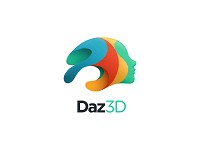Top 3d Modelling Softwares Softwares
3D Modelling Softwares software is essential for creating detailed and precise digital models in various industries. These tools enable designers, architects, and engineers to visualize and simulate objects or structures in a virtual environment. They offer features such as sculpting, texturing, and rendering to transform ideas into realistic 3D models. This software supports creativity and innova... Read More
93 companies found
Product Description
Shivaami is your go-to company for cloud solutions, particularly for businesses looking to streamline their operations and improve efficiency. Specializing in online tools and platforms, Shivaami helps companies of all sizes transition to the cloud smoothly. What makes Shivaami stand out is its focus on personalized service. Instead of offering a one-size-fits-all approach, it takes the time to u... Read More
Users
- • No Data
Industries
- • No Data
Market Segment
- • No Data
Product Description
Daz 3D is an innovative software solution designed for creating detailed 3D graphics and animations with ease. Whether you're an artist, game developer, or someone who just loves 3D design, Daz 3D provides a user-friendly platform to bring your visions to life. The software comes with a library of models, props, and environments that you can customize to suit your needs. One of its most attracti... Read More
Users
- • No Data
Industries
- • No Data
Market Segment
- • No Data
Product Description
GrabCAD is a handy software tool designed to make collaboration easier for teams working on engineering and design projects. It's perfect for anyone who needs to share CAD files with coworkers or external partners without the usual hassle of email attachments or cloud storage links. With GrabCAD, you can store all your project files in one place, making it simpler to organize and manage everything... Read More
Users
- • No Data
Industries
- • No Data
Market Segment
- • No Data
Product Description
Sculpteo is an online 3D printing service that simplifies turning digital designs into tangible products. Whether you're a hobbyist, a small business owner, or part of a large enterprise, Sculpteo provides a seamless way to bring your ideas to life with high-quality 3D printing options. At its core, Sculpteo offers a user-friendly platform where you can upload your 3D models, choose from a variet... Read More
Users
- • No Data
Industries
- • No Data
Market Segment
- • No Data
Fusion 360
Product Description
Fusion 360 is a user-friendly, cloud-based 3D CAD, CAM, and CAE tool for product design and manufacturing. Imagine being able to design, test, and fabricate products all within one platform. That’s exactly what Fusion 360 offers, making it perfect for startups, engineers, and designers who are looking to streamline their workflow without dealing with multiple software programs. The thing that set... Read More
Users
- • No Data
Industries
- • No Data
Market Segment
- • No Data
Product Description
Flixstock is an innovative software company designed to simplify the world of product photography for online retailers. The platform offers a seamless way to create high-quality images for e-commerce stores with minimal effort. Traditionally, obtaining professional product images has been a cumbersome process involving photographers, studios, and sometimes even high costs. Flixstock aims to change... Read More
Users
- • No Data
Industries
- • No Data
Market Segment
- • No Data
Product Description
Infurnia is an innovative software platform designed to simplify and enhance interior design and architecture projects. Whether you're an architect, interior designer, or a furniture company, Infurnia equips you with the tools to create detailed, professional designs without the hassle. Gone are the days of struggling with cumbersome design processes. With Infurnia, you can easily draft floor pla... Read More
Users
- • No Data
Industries
- • No Data
Market Segment
- • No Data
Product Description
Cedreo is an intuitive software designed for professionals in fields like home building, remodeling, real estate, and interior design. It simplifies the often complex process of creating 3D home designs. With Cedreo, users can create complete home plans, from the initial floor plan to the final 3D rendering, all in a single platform. What sets Cedreo apart is its user-friendly interface. You don'... Read More
Users
- • No Data
Industries
- • No Data
Market Segment
- • No Data
Product Description
Physna is a software that's designed to make working with 3D models a whole lot easier. Think of it as a tool that helps you understand and manage 3D shapes, much like how text-based tools help with words and sentences. If your business involves using 3D designs—whether in engineering, manufacturing, or any other field—Physna can simplify and streamline many of your tasks. One of the key features... Read More
Users
- • No Data
Industries
- • No Data
Market Segment
- • No Data
SolidWorks
Product Description
SolidWorks is a leading design and engineering software that makes it easier for businesses and designers to create, simulate, and bring their ideas to life. It's trusted by professionals from various industries—from automotive to aerospace—for its comprehensive set of tools and user-friendly interface. What makes SolidWorks stand out is its integrated 3D CAD (computer-aided design) capabilities.... Read More
Users
- • No Data
Industries
- • No Data
Market Segment
- • No Data
What are the main features of 3D modeling software?
3D Modelling Softwares software enables the creation of three-dimensional digital representations of objects or scenes. These tools cater to various industries, including architecture, gaming, animation, and manufacturing. Understanding the main features of 3D modeling software helps users select the right tool for their specific needs.
User Interface and Usability
3D Modelling Softwares software is designed with an intuitive user interface that allows both beginners and advanced users to navigate its tools and features. A clean and logical layout, often with customizable panels and toolbars, enhances the user experience. The software should allow easy manipulation of the workspace to optimize workflow.
Modeling Tools
The core of 3D Modelling Softwares software is its modeling tools, which enable the creation of complex shapes and forms. These tools include:
- Polygon Modeling: This involves creating 3D objects using vertices, edges, and faces, suitable for detailed modeling.
- NURBS Modeling: Stands for Non-Uniform Rational B-Splines, NURBS offer precision in creating smooth, curved surfaces.
- Parametric Modeling: Provides a flexible creation process, allowing changes to parameters that dynamically update the model.
Texturing and Materials
3D modeling software provides robust options for texturing, enabling users to apply colors, patterns, and images to a model's surface. Advanced tools support:
- UV Mapping: Ensures textures map correctly onto the model's surface.
- Material Libraries: Offers pre-defined materials and the ability to create custom ones for specific visual effects.
- Shaders: Control how light interacts with surfaces, giving more realism to the model.
Rendering Engines
Rendering is integral to 3D Modelling Softwares software, converting models into high-quality images or animations. Features include:
- Real-time Rendering: Allows users to view changes instantly, aiding in quick decision-making.
- Photorealistic Rendering: Uses global illumination and ray tracing to achieve lifelike images.
- Batch Rendering: Processes multiple files or frames automatically, saving time and effort.
Animation Capabilities
Many 3D modeling tools offer animation features for creating dynamic scenes. These capabilities include:
- Rigging: Provides a skeleton framework to animate complex characters.
- Keyframe Animation: Allows users to set start and end points, generating in-between frames automatically.
- Simulation: Mimics real-world physics for effects such as cloth, water, and particles.
Collaboration and File Compatibility
3D modeling requires collaboration; therefore, software offers features to facilitate teamwork and compatibility. Common features are:
- File Import/Export: Supports various formats, ensuring compatibility with other 3D Modelling Softwares software and tools.
- Version Control: Ensures that team members work on the latest project iteration, preventing data loss.
- Cloud Integration: Enables easy sharing and accessing of files across platforms and devices.
Customization and Scripting
Advanced users may require customization to enhance efficiency. 3D Modelling Softwares software offers:
- Plugin Support: Allows for third-party extensions that add specific functionalities.
- Scripting and Automation: Enables the creation of custom scripts to automate repetitive tasks, improving productivity.
By focusing on these key features, users can better assess which 3D Modelling Softwares software aligns with their needs, facilitating the creation of detailed and impressive 3D models.
How can 3D modeling software be used in architecture?
Visualization
3D Modelling Softwares software profoundly transforms how architects visualize structures. By using advanced features, architects create detailed models that go beyond traditional sketches and blueprints. These models offer rich, interactive visuals, allowing architects to present their vision in a tangible form. This enhances client presentations by giving stakeholders a comprehensive view of the project, including aspects like texture, light, and shadows within the proposed design.
Design Exploration
By deploying 3D Modelling Softwares software, architects can explore different design possibilities quickly. The flexibility of these tools allows them to test various layouts, materials, and structural elements without starting from scratch. They can make real-time changes, optimizing dimensions and configurations effortlessly. This iterative process facilitates innovative design by allowing exploration of options that may not have been feasible with traditional methods.
Precision and Accuracy
3D Modelling Softwares software enhances precision in architectural design. Architects use the software to measure dimensions accurately and to ensure all elements are well-aligned. This accuracy significantly reduces errors in the design phase, which can prevent costly mistakes during construction. The software provides tools to simulate load stresses, thermal conditions, and other physical properties, ensuring that the design meets safety and compliance standards.
Collaboration
In modern architecture, collaboration is crucial. 3D Modelling Softwares software fosters teamwork among architects, engineers, designers, and clients. These tools often support cloud-based environments where multiple users can work on the same project simultaneously. By using 3D models, they can share insights and feedback in real time, ensuring that everyone involved has the same understanding of the project objectives and progress.
Efficient Planning
3D Modelling Softwares software streamlines the planning and execution of architectural projects. By simulating construction processes, architects can anticipate potential issues and address them proactively. This forward planning capability helps reduce delays and optimize resources. Moreover, the software can generate documentation and reports, providing comprehensive data needed for the construction phase.
Enhanced Communication
Using 3D Modelling Softwares software improves communication among project stakeholders. Visual models convey complex architectural concepts more effectively than text-based descriptions or 2D drawings. Stakeholders can engage with interactive models, offering a better understanding of the final product. This clarity minimizes misunderstandings and aligns expectations across all parties involved in the project.
Sustainability Evaluation
Sustainability has become an essential aspect of architecture. 3D Modelling Softwares software can evaluate environmental factors, helping architects design eco-friendly structures. They can simulate energy consumption, analyze natural light penetration, and assess the environmental impact of materials. This data-driven approach enables architects to make informed decisions that align with sustainability goals.
Legacy Integration
In heritage architecture, 3D Modelling Softwares software is invaluable. It assists architects in restoring, renovating, or preserving historical sites. Using detailed scans of existing structures, architects create accurate 3D models that respect the integrity of the original design while integrating new elements seamlessly.
Final Note
Through these varied applications, 3D Modelling Softwares software has established itself as an integral tool in modern architecture, elevating the field with innovative capabilities that reshape how projects are conceptualized and executed.
What industries benefit most from 3D modeling software?
Architecture and Construction
The architecture and construction industries significantly benefit from 3D Modelling Softwares software. These tools allow architects and builders to create detailed and accurate representations of buildings and structures. By utilizing 3D modeling, professionals can visualize and modify designs more efficiently than traditional 2D blueprints. This facilitates better communication among team members and clients, ensuring a clearer understanding of project goals and design elements.
Engineering and Manufacturing
Engineering and manufacturing industries use 3D Modelling Softwares software to enhance product design and development. Engineers rely on these tools for prototyping, testing, and refining product designs. The software helps simulate real-world functionalities and conditions, reducing the need for multiple physical prototypes. This leads to cost savings and faster time-to-market by allowing teams to identify and resolve design issues early in the process.
Film and Animation
In the film and animation sector, 3D Modelling Softwares software is essential for creating visually stunning graphics and animations. Animators and special effects artists use these tools to generate lifelike characters and immersive environments. The ability to model objects and scenes in 3D is crucial for producing high-quality digital content that captivates audiences while meeting the demanding visual standards of the entertainment industry.
Game Development
Game development extensively uses 3D Modeling Softwares software to build intricate and interactive virtual worlds. Game designers create detailed characters, levels, and assets, leveraging 3D models to enhance player engagement. Advanced capabilities like realistic textures and lighting effects significantly contribute to the immersion of gaming experiences, making them more dynamic and lifelike.
Healthcare and Medicine
Healthcare and medicine industries benefit from 3D Modelling Softwares software for educational, diagnostic, and treatment purposes. In medical imaging, these tools help visualize complex anatomical structures, aiding in diagnosis and planning of surgical procedures. Additionally, 3D modeling is employed in creating patient-specific prosthetics and implants, ensuring a precise fit based on individual anatomical data.
Interior Design
Interior designers use 3D Modelling Softwares software to visualize room layouts and décor arrangements. It aids them in creating realistic renderings that clients can explore and assess before making final decisions. Designers can make swift modifications to color schemes, furniture placement, and other design elements, enhancing the overall design process and client satisfaction.
Automotive Industry
The automotive industry benefits significantly from 3D Modelling Softwares software for designing vehicles and components. Design teams use these tools for styling and functional testing of car parts and systems, leading to innovative and efficient designs. The ability to conduct virtual simulations for aerodynamics and safety features enhances product development by reducing the need for physical testing.
Fashion and Apparel
3D Modelling Softwares software impacts the fashion and apparel industry by facilitating garment design and production. Designers use these tools to craft patterns and visualize how fabrics will drape on the human form, improving accuracy and efficiency in the design process. With advancements in technology, virtual fashion collections can be presented without the need for physical samples, reducing waste and production costs.
These industries, among others, extensively benefit from the advanced capabilities provided by 3D Modelling Softwares software, enhancing efficiency, creativity, and product quality.
How does 3D modeling software improve product design?
Enhanced Visualization
3D Modelling Softwares software enhances product design by offering a realistic visualization of concepts. Designers can create detailed models that mirror the final product. This visual representation allows stakeholders to understand dimensions, aesthetics, and functionality early in the design phase. It bridges the gap between idea and execution, making it easier to realize innovations and improvements.
Improved Communication
Clear communication among team members and stakeholders is vital in product design. 3D Modelling Softwares software facilitates this by providing clear and interactive visuals. Instead of relying on 2D drawings or verbal descriptions, teams can share dynamic 3D models. This shared understanding reduces misunderstandings and aligns teams towards common goals, accelerating the decision-making process.
Increased Iteration Speed
Design modifications are often necessary to meet design standards and client requirements. With 3D Modelling Softwares software, making alterations is more efficient. The ability to swiftly adjust the model and instantly view the results speeds up the iterative process. Designers can evaluate multiple design variations in less time, ensuring a more polished final product.
Cost Efficiency
Using 3D Modelling Softwares software can reduce costs associated with physical prototyping. Before fabrics or materials are wasted on unsuccessful designs, virtual models can be tested for aesthetics and functionality. This reduces the need for multiple physical prototypes, saving both time and resources. By cutting down on production costs, companies can allocate their budgets to innovation and market research.
Enhanced Prototyping and Testing
3D Modelling Softwares software enables more robust prototyping and testing. By simulating real-world conditions and interactions within the software, designers can identify potential issues before creating physical prototypes. This ensures products are better refined and ready for production, leading to higher-quality outcomes. Virtual testing also facilitates rigorous analysis without the constraints of physical prototypes.
Streamlined Collaboration
Collaboration is crucial in product design, particularly across geographically disparate teams. 3D Modelling Softwares software supports streamlined collaboration by enabling teams to work on a single model from different locations. Cloud-based functionalities allow real-time access and editing, ensuring everyone stays on the same page. This flow of information and ideas fosters creativity and innovation within teams.
Facilitates Customization
3D Modelling Softwares software makes customization easy, meeting specific client needs or market niches. Design alterations are more fluid and can be executed without disrupting the entire model. These tailored options not only meet client specifications but also offer unique solutions that differentiate products in competitive markets.
Improved Quality Assurance
By providing accurate models with detailed specifications and measurements, 3D Modelling Softwares software aids in quality assurance. Errors can be identified and rectified before production begins, ensuring that the final product adheres to design intentions. This minimizes the risk of costly mistakes, enhancing overall product quality and consistency.
In summary, 3D Modelling Softwares software significantly enhances product design by improving visualization, communication, iteration, and more. This technological tool empowers designers to bring innovative products to life efficiently and effectively, aligning with modern design standards and expectations.
What should beginners look for in 3D modeling software?
When venturing into the realm of 3D Modelling Softwares software, beginners should carefully evaluate several factors to find the most suitable tool for their needs. Choosing the right software will facilitate learning and ease the process of creating 3D models.
User-Friendly Interface
The first consideration should be the software's interface. A beginner-friendly interface can significantly reduce the learning curve. Look for 3D Modelling Softwares software that offers intuitive navigation and clear tool organization. An easy-to-understand interface helps beginners focus on learning modeling fundamentals rather than interpreting complex menus.
Learning Resources
Consider the availability of learning resources. Software with ample tutorials, documentation, and user communities will aid beginners in self-paced learning. Beginner-friendly 3D Modelling Softwares software often comes with comprehensive guides, video tutorials, and forums for support, enabling new users to find solutions and advice easily.
Basic Tools and Functions
Beginners need access to essential tools within the 3D Modelling Softwares software. While advanced features might not be necessary initially, basic modeling tools such as extrusion, scaling, and rotation are crucial. Beginners should ensure the software offers these basic functions to start creating simple models and gradually advance their skills.
Cost and Licensing
Beginners should also consider the cost and licensing model of the 3D Modelling Softwares software. Some software offers free versions or trials, ideal for those just starting. Evaluate whether investing in premium features is necessary at the beginner stage, or if a free version suffices for initial learning.
Cross-Platform Compatibility
Cross-platform compatibility can also be important. Beginners using different devices or operating systems should check if the 3D Modelling Softwares software runs smoothly on their hardware. Software supporting multiple platforms offers flexibility, accommodating future changes in the user's hardware preferences.
Community and Support
Community support is invaluable for beginners. Software with active user forums or communities can provide immediate assistance and tips. Engaging with a supportive online community helps beginners resolve issues and share experiences while using 3D Modelling Softwares software.
Performance Requirements
Finally, consider the software's performance requirements. Some 3D Modelling Softwares software may demand significant computer resources. Beginners should ensure their hardware is capable of running the software smoothly to avoid frustration with slow performance or crashes.
Focusing on these aspects will help beginners select 3D Modelling Softwares software that best fits their needs. Users can begin their 3D modeling journey on the right foot by choosing a tool that balances ease of use, affordability, and basic functionality.
How does 3D modeling software integrate with virtual reality?
Integration Overview
3D Modelling Softwares software plays a significant role in integrating with virtual reality (VR) by providing the essential tools for creating virtual environments and objects. These programs serve as the foundation for designing and simulating objects that are later implemented in VR. The intricate workflows involved in integrating these two technologies enable users to experience a realistic representation of their designs and models within a virtual space.
Model Creation and Importing
3D Modelling Softwares software allows designers to create detailed models and scenes. These models are crafted using advanced tools and techniques that ensure accuracy and realism. After the completion of these models, they can be imported into VR environments. This import process usually requires file conversion to formats that are compatible with VR applications. The software often supports a variety of file types, ensuring seamless integration and transition from creation to virtual interaction.
Real-Time Interactivity
Once models are uploaded into the VR environment, users can interact with these objects in real-time. 3D Modelling Softwares software enables real-time rendering which is crucial for VR experiences. This feature ensures that the objects appear in high definition within the virtual space and respond instantly to the user's actions. Real-time interactivity enhances the immersive nature of VR, providing a more engaging experience.
Scale and Measurement Adjustments
The integration of VR and 3D modeling allows for accurate scaling and measurement adjustments. Within VR, users can manipulate 3D modeled objects to assess their dimensions and proportions in a life-like scenario. This capability is beneficial in fields where precision is critical, such as architecture and engineering. 3D Modelling Softwares software supports these adjustments to maintain model integrity and realism during VR interactions.
Collaborative Design
3D Modelling Softwares software facilitates collaborative design processes by integrating with VR. Multiple users can access the same virtual environment to view and modify models in real-time. This collaborative aspect is enhanced by the immersive nature of VR, which allows teams to better visualize changes and make informed decisions collectively. 3D modeling software supports these integrations through features that enable synchronised model updates and sharing.
Enhanced Visualization
Visualization is significantly enhanced when integrating 3D Modelling Softwares software with VR technology. VR provides a three-dimensional space where users can experience and evaluate models from various angles and perspectives. This enhanced visualization offers insights that are not possible through traditional two-dimensional screens, allowing users to understand spatial relationships and aesthetics better.
Application in Diverse Fields
The integration of 3D Modelling Softwares software with VR is applicable in numerous fields such as architecture, product design, gaming, and education. This integration allows professionals from different industries to leverage VR's immersive capabilities for mockups, prototypes, and virtual tours. 3D modeling tools provide the foundational designs and structures, which are then transformed into vivid VR experiences.
3D Modelling Softwares software and VR integration is a dynamic process that elevates the quality and capabilities of virtual environments. Through real-time interaction, collaborative tools, and enhanced visualization, users can experience and manipulate 3D models effectively, paving the way for innovative solutions in various sectors.
What are the system requirements for running 3D modeling software?
To effectively run 3D Modelling Softwares software, a computer must meet certain system requirements. These criteria ensure that the software operates smoothly without lag or crashes, enhancing productivity and user experience. Below are crucial components and considerations for determining adequate system requirements:
Processor (CPU)
The processor is a key component in 3D Modelling Softwares software. A multi-core processor is often recommended. Generally, an Intel Core i5 or AMD Ryzen 5 is a suitable minimum for basic models. For complex models, however, an Intel Core i7 or AMD Ryzen 7 or higher is advisable to handle demanding tasks efficiently.
Memory (RAM)
Memory plays a vital role in managing large files and complex operations that are typical in 3D Modelling Softwares software. A baseline of 8GB RAM could be functional for simpler projects, but for optimal performance and future-proofing, at least 16GB RAM is recommended. Professionals often opt for 32GB or more to manage multiple tasks concurrently.
Graphics Card (GPU)
A dedicated graphics card is crucial for rendering and visualizing models with high detail. An entry-level card, such as the NVIDIA GTX 1050 or AMD Radeon RX 560, can suffice for basic tasks. For more comprehensive projects, an NVIDIA GTX 1660 or AMD Radeon RX 580 should be considered. High-end 3D Modelling Softwares software might require NVIDIA RTX series or equivalent for real-time rendering.
Storage
Storage impacts data access and saving speed. Solid State Drives (SSD) offer faster data retrieval than Hard Disk Drives (HDD). A combination of both — with at least 256GB SSD for software and a 1TB HDD for data storage — ensures effective performance. High-performance workflows in 3D Modelling Softwares software may benefit from larger SSDs to accommodate large project files.
Operating System
3D Modelling Softwares software typically supports both Windows and macOS. Ensure the latest operating system version for compatibility with new features and security improvements. Windows 10 or macOS Big Sur (or higher) is often recommended.
Display
A high-resolution display aids in scrutinizing model details accurately. Full HD (1920x1080) is a minimum standard. For professional uses, 4K screens provide superior clarity and detail, which is useful in intricate modeling tasks.
Additional Peripherals
For effective use of 3D Modelling Softwares software, devices such as styluses, drawing tablets, and a mouse with programmable buttons can enhance precision and efficiency. These peripherals complement the software tools, easing tasks and improving intricate design workflows.
Meeting these system requirements will significantly influence the performance of 3D Modelling Softwares software, facilitating a smoother modeling experience. The balance of components, like CPU, GPU, and RAM, determines the capacity to handle complex models and intensive rendering tasks efficiently. Therefore, investing in the appropriate hardware according to the software's needs is essential for optimal use.









